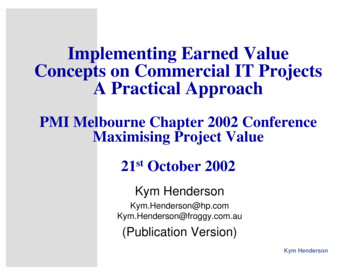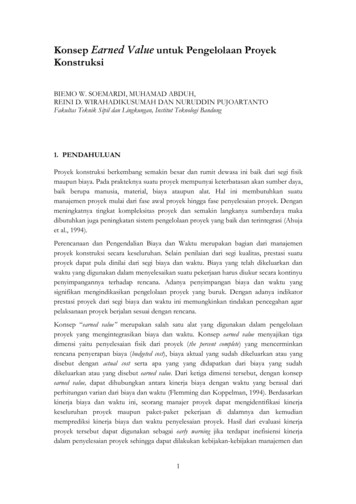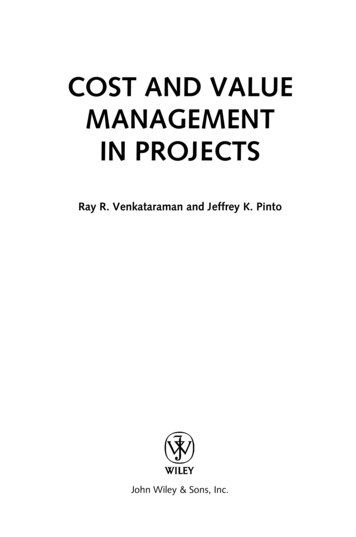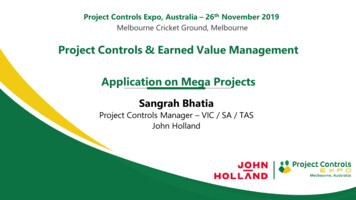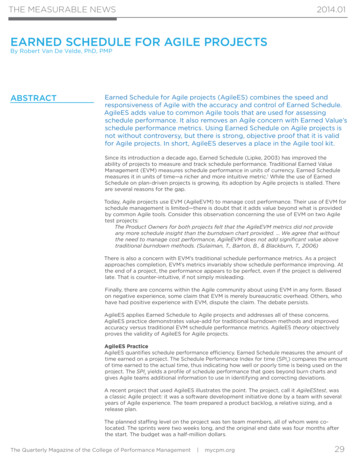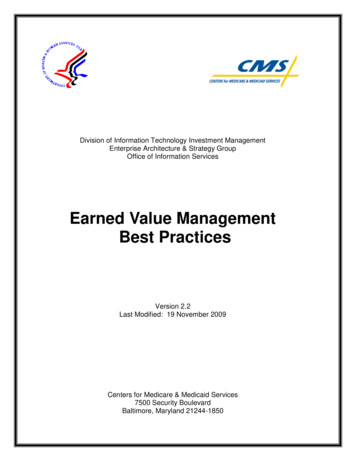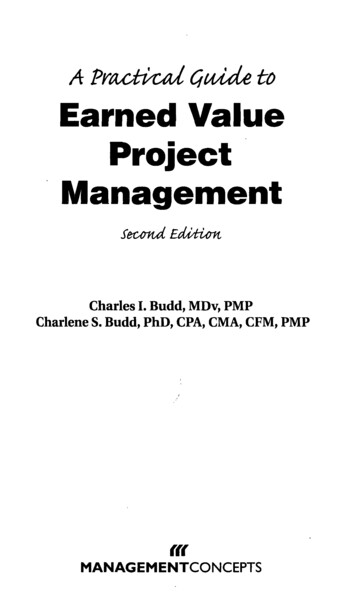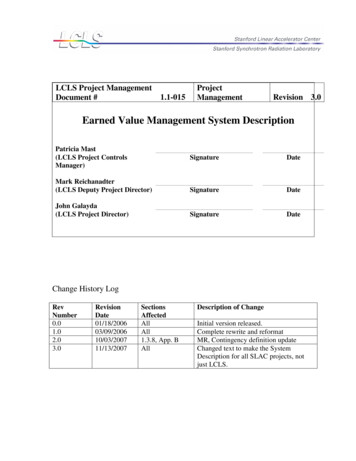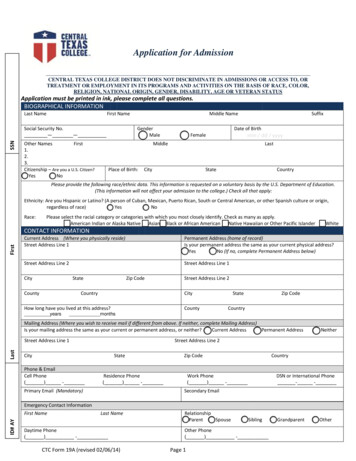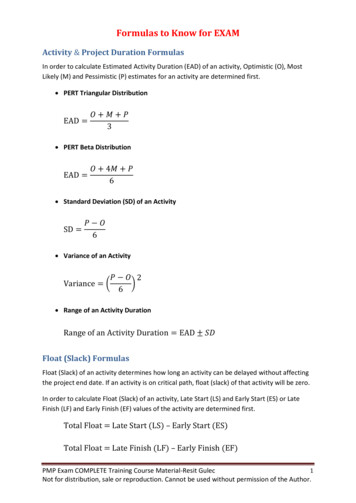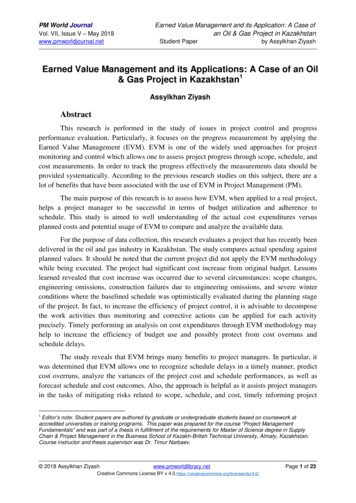
Transcription
PM World JournalVol. VII, Issue V – May 2018www.pmworldjournal.netEarned Value Management and its Application: A Case ofan Oil & Gas Project in KazakhstanStudent Paperby Assylkhan ZiyashEarned Value Management and its Applications: A Case of an Oil& Gas Project in Kazakhstan1Assylkhan ZiyashAbstractThis research is performed in the study of issues in project control and progressperformance evaluation. Particularly, it focuses on the progress measurement by applying theEarned Value Management (EVM). EVM is one of the widely used approaches for projectmonitoring and control which allows one to assess project progress through scope, schedule, andcost measurements. In order to track the progress effectively the measurements data should beprovided systematically. According to the previous research studies on this subject, there are alot of benefits that have been associated with the use of EVM in Project Management (PM).The main purpose of this research is to assess how EVM, when applied to a real project,helps a project manager to be successful in terms of budget utilization and adherence toschedule. This study is aimed to well understanding of the actual cost expenditures versusplanned costs and potential usage of EVM to compare and analyze the available data.For the purpose of data collection, this research evaluates a project that has recently beendelivered in the oil and gas industry in Kazakhstan. The study compares actual spending againstplanned values. It should be noted that the current project did not apply the EVM methodologywhile being executed. The project had significant cost increase from original budget. Lessonslearned revealed that cost increase was occurred due to several circumstances: scope changes,engineering omissions, construction failures due to engineering omissions, and severe winterconditions where the baselined schedule was optimistically evaluated during the planning stageof the project. In fact, to increase the efficiency of project control, it is advisable to decomposethe work activities thus monitoring and corrective actions can be applied for each activityprecisely. Timely performing an analysis on cost expenditures through EVM methodology mayhelp to increase the efficiency of budget use and possibly protect from cost overruns andschedule delays.The study reveals that EVM brings many benefits to project managers. In particular, itwas determined that EVM allows one to recognize schedule delays in a timely manner, predictcost overruns, analyze the variances of the project cost and schedule performances, as well asforecast schedule and cost outcomes. Also, the approach is helpful as it assists project managersin the tasks of mitigating risks related to scope, schedule, and cost, timely informing projectEditor’s note: Student papers are authored by graduate or undergraduate students based on coursework ataccredited universities or training programs. This paper was prepared for the course “Project ManagementFundamentals” and was part of a thesis in fulfillment of the requirements for Master of Science degree in SupplyChain & Project Management in the Business School of Kazakh-British Technical University, Almaty, Kazakhstan.Course instructor and thesis supervisor was Dr. Timur Narbaev.1 2018 Assylkhan Ziyashwww.pmworldlibrary.netCreative Commons License BY v ge 1 of 23
PM World JournalVol. VII, Issue V – May 2018www.pmworldjournal.netEarned Value Management and its Application: A Case ofan Oil & Gas Project in KazakhstanStudent Paperby Assylkhan Ziyashcustomers on potential issues regarding project progress and performance, and implementingcorrective actions as necessary.Keywords: Earned Value Management (EVM), Project Control, Oil and Gas, Kazakhstan.IntroductionAll projects create change; many projects change lives in significant ways and, in manyparts of the world, projects actually save lives. To be successful, all projects should be plannedand implemented properly. The PM World Library provides information and resources formanaging projects, information not always available in many places and in many organizations.Project management information and knowledge can lead to more successful projects,transforming lives and creating a better future. (PM World Journal, 2016).1.1 DefinitionThe Project Management Institute’s (PMI) definition of Earned Value Management(EVM) is a method for integrating scope, schedule, and resources, and for measuring projectperformance. It compares the planned amount of work with what was actually earned with whatwas actually spent. This is to determine if cost and schedule performances are as planned (PMI,2008). EVM known as “management with the lights on”, is based on the principle that pastpatterns and trends can indicate future conditions. EVM helps you clearly and objectively seewhere your project is headed compared to where it’s supposed to be (PMI, Practice Standard forEarned Value Management, 2011). Kerzner (2013) stated that EVM emphasizes prevention overcures by finding and agreeing project performance and progress issues as early as possible.EVM is an early warning system allowing for early identification of trends and variances from aplan. It allows a Project Manager (PMr) sufficient time to make course corrections in smallincrements. It is usually easier to correct small variances as opposed to large variances.Therefore, EVM should be used periodically throughout the project to determine the varianceswhile they are small and possibly easy to take corrective actions. Large variances are moredifficult to correct, has bigger impact and they may displease management to the point where theproject may be cancelled.EVM has been used to forecast cost at completion for over four decades (De Marco et al.,2016). This objective methodology integrates project cost, schedule and scope metrics into asingle measurement system. It is widely applied for measuring and analyzing project actualstatus against its baseline, and for providing estimates of project cost and duration at completion(Narbaev and De Marco, 2017). According to Settlemire (2016), in his research paper called “ATheoretical Approach to Traditional Project Metrics-Bridging the Gap between Earned Valueand Critical Path Project Management”, describes as, EVM is a commonly used method forproject performance measurements. EVM focuses on monitoring and controlling project metricsaimed at efficiency and effectiveness reporting. Two commonly used metrics include CostPerformance Index (CPI) and Schedule Performance Index (SPI). CPM is used to determine thelongest path of activities throughout the duration of the project. Tasks residing on this path are 2018 Assylkhan Ziyashwww.pmworldlibrary.netCreative Commons License BY v ge 2 of 23
PM World JournalVol. VII, Issue V – May 2018www.pmworldjournal.netEarned Value Management and its Application: A Case ofan Oil & Gas Project in KazakhstanStudent Paperby Assylkhan Ziyash“critical,” as delay in these activities can result in delay to the overall project. EVM calculationsdo not take into full consideration the criticality of tasks that are on the critical path exclusively.Calculations do not differentiate tasks that are “critical” from those that are not. Tasks aretreated uniformly and are considered equal throughout EVM calculations”. EVM is a projectmanagement technique for measuring project performance and progress.This research is to help to project practitioners to evaluate performance of the budget andactual progress-to-date use. This will help to understand if the actual cost is within the budgetand the tasks are aligned with baselined schedule which are prescribed in a work breakdownstructure (WBS). The term ‘value’ defines the work at the date of analysis that represents theamount of the control budget earned, rather than the actual cost.The forecasting method in this research utilizes the performance data obtained through theEVM. This method can provide early prediction of final result of the project. A forecastingprocess should be performed in a proactive manner in order to support a project during planningand execution.1.2 Research PurposeThe main purpose of this research is to assess how the EVM system, when applied to areal project, helps project managers to be successful in budget utilization and scheduleperformance. The data obtained in this research can be compared with other similar projects.The proposed methodology can be used to improve the future project execution and thereforemeet stakeholder’s expectations.1.3Research ObjectivesThis research should enable practitioners who have not yet practiced the EVMmethodology in various performance data analysis. According to Narbaev’s research (2015),many companies in Kazakhstan have not been practicing the EVM methodology. This is causedby lack of requirements in performance data analysis and PM organizational capabilities. TheEVM method requires measuring the data on execution phase of the project that includesengineering and construction activities. Especially during construction activities, monthly dataanalysis will enable to timely act on some delays or overspending. Specific industryrequirements, with combination of complicated logistic arrangements, the projects in theKazakhstanis oil and gas sector can have comparatively high execution cost. Cost of execution,especially if contractor has been asked to complete in optimistic timeframe, may increase theproject cost significantly. Thereby the cost performance becomes a second priority giving theschedule requirements being performed at first.Many of project managers are facing challenges in projects. It can be a poor performancein monitor and control of the project and lack of organizational capability. Accurateperformance indicators like cost and schedule performances are critical to support decisionmaking and predictable projects’ results. According to recommended practices of Associationfor the Advancement of Cost Engineering (AACE, 2016), a proper application of EVM 2018 Assylkhan Ziyashwww.pmworldlibrary.netCreative Commons License BY v ge 3 of 23
PM World JournalVol. VII, Issue V – May 2018www.pmworldjournal.netEarned Value Management and its Application: A Case ofan Oil & Gas Project in KazakhstanStudent Paperby Assylkhan Ziyashprocesses and tools in each phase of the project increases the likelihood that the projects willachieve their cost and budget commitments and therefore enhance stakeholder’s credibility.1.4Background ResearchDepartment of Defense (DoD) EVMS (EVM System) Interpretation Guide defines theEVM as, a widely accepted industry best practice for program management that is used acrossthe DoD, the Federal government, and the commercial sector. Government and industry programmanagers use EVM as a program management tool to provide joint situational awareness ofprogram status and to assess the cost, schedule, and technical performance of programs forproactive course correction. EVMS is the management control system that integrates program’swork scope, schedule, and cost parameters for optimum program planning and control. To beuseful as program management tool, program managers must incorporate EVM into theiracquisition decision-making processes; the EVM performance data generated by the EVMSmust be timely, accurate, reliable, and auditable; and the EVMS must be implemented in adisciplined manner consistent with the 32 EVMS Guidelines prescribed in Section 2 of theElectronic Industries Alliance Standard-748 EVMS (EIA-748) (Reference (a)), hereafterreferred to as “the 32 Guidelines.According to Performance Assessments and Root Cause Analyses (PARCA) EVMdivision in the Office of the Assistant Secretary of Defense for Acquisition, EVM is one ofDoD’s and industry’s most powerful program planning and management tools. The purpose ofEVM is to ensure sound planning and resourcing of all tasks required for contract performance.It promotes an environment where contract execution data is shared between project personneland government oversight staff and in which emerging problems are identified, pinpointed, andacted upon as early as possible. EVM provides a disciplined, structured, objective, andquantitative method to integrate technical work scope, cost, and schedule objectives into a singlecohesive contract baseline plan called a Performance Measurement Baseline for trackingcontract performance.According to Narbaev’s research on identification of maturity level of Kazakhstani’sorganizations (Narbaev, 2015a, 2015b), the majority of Kazakhstani companies are facingsignificant problems in projects while performing them. Narbaev says, that based on the resultsof the PjM3 questionnaire with the mean maturity level of 2.42 out of 5, the study found out thatPM tools and methods have not yet been used effectively in Kazakhstan. PMM in Kazakhstaniorganizations is gradually moving from Level 2 to Level 3. This shows that the organizationsensure that each project is run with its own processes and procedures to a minimum specifiedmanagement standard set in the organizations. However, he has also indicated that there waslimited consistency or coordination between different projects. Finally, the findings suggestedthat, as the maturity moves to Level 3, the organizations strived for having their own centrallycontrolled PM processes where all their individual projects would flex. All in all, the findings ofthe study add value to the existing PM body of knowledge in Kazakhstan and are backgroundasset to be used in facilitating the ‘projectification’ of organizations in Kazakhstan. 2018 Assylkhan Ziyashwww.pmworldlibrary.netCreative Commons License BY v ge 4 of 23
PM World JournalVol. VII, Issue V – May 2018www.pmworldjournal.netEarned Value Management and its Application: A Case ofan Oil & Gas Project in KazakhstanStudent Paperby Assylkhan ZiyashAccurate performance indicators like cost and schedule performances are critical tosupport decision making and predictable projects’ results. According to Guideline 7 of theANSI/EIA-748 standard, objective indicators enable to measure the actual physical workallowing accurate comparison with planned work. Meaningful performance metrics enable bettermanagement insight and decision-making, ensuring that maximum time is allowed formanagement action to keep the project on plan. EVM practitioners should understand that ifeffectively use and treat the performance data the project products and outcomes will beachieved.Besner and Hobbs (2006) in their research paper which is called “The Perceived Value andPotential Contribution of Project Management Practices to Project Success”, says that there is alack of use the EVM though being intensely studied.According to Turner (2009), the EVM has currently become a key, recognized techniquefor PMr. Many practitioners are recommending as a powerful tool. The Figure 1 below, showsan overview of the full technique of EVM analysis.Figure 1 – An Example of EVM analysis (Turner, 2009)In fact, the comparison of PV and AC tells PMr nothing. If AC is less than PV we do notknow if that is because the work is underspent, or lack in schedule. In fact, one of the mostmisleading things is when the work is well behind schedule and overspent, but you are calmedinto thinking it is underspent. For this reason, we also need to monitor how much work hasalready been done. We do this by calculating the value earned, that is the estimated cost of thework that has been done for the money spent to date (Turner, 2009).Naderpour (2011) identified that, project control tools are commonly used in theconstruction industry. Unfortunately, many projects run over budget and behind schedule, whichsuggests that there is something wrong in our project control system. EVM is project control 2018 Assylkhan Ziyashwww.pmworldlibrary.netCreative Commons License BY v ge 5 of 23
PM World JournalVol. VII, Issue V – May 2018www.pmworldjournal.netEarned Value Management and its Application: A Case ofan Oil & Gas Project in KazakhstanStudent Paperby Assylkhan Ziyashtechnique that provides quantitative measure of work performance. It is considered the mostadvanced technique for integration of schedule and cost.Vandevoorde (2006) published a research paper called “A comparison of different projectduration forecasting methods using earned value metrics”. and defined as, earned value projectmanagement is a well-known management system that integrates cost, schedule and technicalperformance. It allows the calculation of cost and schedule variances and performance indicesand forecasts of project cost and schedule duration. The EV method provides early indications ofproject performance to highlight the need for eventual corrective action. EVM was originallydeveloped for cost management and has not widely been used for forecasting project duration.However, recent research trends show an increase of interest to use performance indicators forpredicting total project duration.The research that was conducted by KPMG in India (KPMG, 2013), explains the problemwith project schedule and cost overruns is in criticality of addressing the highly skilledprofessionals. The survey suggests that there is a dearth of manpower across categories;however, non-availability of highly-skilled professionals can have an adverse impact on theproject delivery and cost. Dearth of skilled PMr has the greatest influence on project delivery.Shortage of skilled PMr emerges as the root cause for time and cost overruns in the projectlifecycle. It has been observed that the inflow of talent in the infrastructure sector has beendeclining – as resources are going for alternative, more lucrative options. This concern is feltacross various stages of project lifecycle.Per the AACE (2014), the methodology is highly important to use and practical to achievethe results if recommendations are followed. The strengths of an EVM are that it integrates costand schedule performance assessment of variances from plans while being objective andquantitative. However, the method in itself does not explain why the performance is what it is,nor how performance can be improved. It simply waves a red flag when there are problem areasthat need further assessment, or when positive performance needs to be assessed for potentialreduction in project costs and/or early completion. Hollman (2012) Total Cost ManagementFramework.Solanki (2009), in EVM book defines that it is very important to recognize that EVMSrequirements should be implemented to provide the management information needed byprogram management for effective management of the contract or project. In addition, it isimportant to recognize that no single EVMS application can meet every management need forperformance measurement due to variations in organizations, products, processes, and workingrelationships.Giammalvo (2013), in his research paper published in PM World Library, concludes thatEVM, applied in a “common sense” manner, can provide us with a way to measure and managethose projects in a way that should ensure that the project is “successful”- on time, withinbudget, in substantial conformance to the technical and contractual requirements. And if usedappropriately, EVM affords us a great tool to identify problems when there is still time to fix 2018 Assylkhan Ziyashwww.pmworldlibrary.netCreative Commons License BY v ge 6 of 23
PM World JournalVol. VII, Issue V – May 2018www.pmworldjournal.netEarned Value Management and its Application: A Case ofan Oil & Gas Project in KazakhstanStudent Paperby Assylkhan Ziyashthem and if the problems are not fixed, then EVM provides a great audit trail to identify thosewho should be held legally and financially accountable for the failure.MethodologyThis research is based on quantitative study applied to real data from the historical projectwhich was implemented to deliver portion of an oil and gas plant. The purpose of this researchto assess how EVM, when applied to a real project, help a PMr to be successful in terms ofbudget utilization and meet the deadlines. The company which provided the data desires to keepanonymity in this research. This study is aimed to well understanding of the actual costexpenditures versus planned costs and potential usage of EVM to compare and analyze theavailable data.With the purpose of accomplishment of the project control exercise, it is important todefine the elements of scope of work into Work Breakdown Structure (WBS). According toPMBoK, WBS is the process of subdividing of project deliverables and project work intosmaller, more manageable components. On the other side for incorporation of data, it ismandatory to identify the organizations of the project for establishment of OrganizationalBreakdown Structure (OBS), which distributes the roles and responsibilities of eachorganization within Company.Following identification of the deliverables and decomposition of the scope of work,normal practice when PMr together with project team develop WBS. Decomposition breakdown on an agreed scope into elements for which work can be planned and controlled in properway. Each element of the WBS should be performed separately, finally resulting the wholeasset. Once completed the WBS, it is important to assign responsible party who will becontrolling an execution of deliverables. An OBS should identify by whom the elements of theWBS will be delivered, allowing for PMr to control the resource availability.Furthermore, combination of the above two structures – WBS and OBS – will deliveranother control document that required within EVMS such as a Responsibility AssignmentMatrix (RAM). With reference to John K. Hollmann (2012), RAM is the intersection of WBSand OBS, which brings up the level, where budget and schedule are measured with its ownresponsible and scope of work. This level is named as Control Account, refer to Figure 2. 2018 Assylkhan Ziyashwww.pmworldlibrary.netCreative Commons License BY v ge 7 of 23
PM World JournalVol. VII, Issue V – May 2018www.pmworldjournal.netEarned Value Management and its Application: A Case ofan Oil & Gas Project in KazakhstanStudent Paperby Assylkhan ZiyashFigure 2 – Example of WBS and OBS relationship (Hollman, TCM, 2012)The EVM method implies that control accounts’ values are summed to the total value forthe project. The percent progress of any sub-tasks of the WBS, at any point in time, is then thesum of the value of each control value in that WBS sub-task that has been earned at that time,divided by the total value of that sub-task of the WBS. The earned value for each control is thevalue multiplied by the earned work measured by EVM techniques of the scope.Project performance measurement is the process of measuring the expenditure or physicalwork status on a project and the degree of completion or status of project work packages ordeliverables, as well as monitoring of how work is being accomplished. Together with projectcost measures of the commitment and expenditure, project performance measures are the basisfor project performance assessment. Fleming and Koppelman (2000). For this purpose, it isimportant that estimate and schedule are well enough developed.The opportunity is to improve the processes on how the critical data should be selected,turn it into valuable information, and use it to improve project performance and its achievement.According to AACE TCM Framework, the progress and performance measurement is theprocess of measuring the expenditure or status of nonmonetary resources on a project (e.g.,tracking the receipt of materials or consumption of labor hours) and the degree of completion orstatus of project work packages or deliverables (e.g., the extent that materials have beeninstalled, deliverables completed, or milestones achieved), as well as observations of how workis being performed (e.g., work sampling). Together with project cost accounting measures of the 2018 Assylkhan Ziyashwww.pmworldlibrary.netCreative Commons License BY v ge 8 of 23
PM World JournalVol. VII, Issue V – May 2018www.pmworldjournal.netEarned Value Management and its Application: A Case ofan Oil & Gas Project in KazakhstanStudent Paperby Assylkhan Ziyashcommitment and expenditure of money, progress and performance measures are the basis forproject performance assessment.PMr receives various cost and schedule reports on a monthly basis to help to identify theaccurate project progress measurements. The table below provides the list of data sources usedto accomplish correctly progress measurement within EVM requirements:PVPlanned ValueEVEarned ValueACActual CostsBACBudget at CompletionBased on above data available within each project, the following measurement indices should beprovided while executing the project, AACE:Cost Variance (CV)EV – ACSchedule Variance (SV)EV – PVVariance at Complete (VAR)BAC – EACCost Performance Index (CPI)EV / ACSchedule Performance Index (SPI)PV/ EVEstimate at Completion (EAC)AC (BAC-EV)/CPIEstimate to Complete (ETC)EAC – ACCPI – The ratio of EV to AC (CPI EV/AC); often used to predict magnitude of apossible cost overrun by dividing it into the original cost estimate (original cost estimate/CPI projected cost at completion), with a:-CPI greater than 1.0, the project is under the control budget.-CPI less than 1.0, the project is over the control budget.-CPI equal to 1.0, the project is exactly on the control budget.SPI – Ratio of work performed (EV) to work scheduled (PV). SPI EV/PV, with a:-SPI greater than 1.0, the project is ahead of schedule.-SPI less than 1.0, the project is behind schedule.-SPI equal to 1.0, the project is on schedule.Variance analysis such as schedule variance will give insight into detail for both ahead ofand behind scheduled work baseline and its trend can provide useful indication of current 2018 Assylkhan Ziyashwww.pmworldlibrary.netCreative Commons License BY v ge 9 of 23
PM World JournalVol. VII, Issue V – May 2018www.pmworldjournal.netEarned Value Management and its Application: A Case ofan Oil & Gas Project in KazakhstanStudent Paperby Assylkhan Ziyashperformance and future projection. Whereas cost variance is a measure of both over and undercost position for work accomplished relative to budget baseline. In addition to both variances, itis also important to analyze the variance at completion, which periodically assesses remainingrequirements and maintain a most likely estimate of cost and schedule to complete projectobjectives. John K. Hollmann (2012).Application to a Case ProjectThe research shows the difference in application of performance measurements. Thehistorical project is analyzed with the aim to find the ways how and where the corrective actionshad to be taken to reach the completion within the budget and schedule.The past example of capital project from the oil and gas industry has been evaluated toconduct the case study and identify the methodology approach for the performancemeasurement. The project is to construct the storage reservoir at the oil and gas plant. Theproject was estimated to complete within 48 months. The initial budget for this project wasestimated as 53mln US Dollars. The scope of this project is to provide additional capacity fortwo interrelated tank systems – off-spec crude and sour water handling. The preferred alternativeto accomplish this is to construct true ’duplicate’ tanks nearly co-located with the existing tanks.The new tank will have a nominal capacity of 10,000 m3. The new tank is built withininternational standards as the existing tank. The tank will tie-in with the suction piping on theexisting pumps. The tank will be internally and externally coated with an appropriate coatingsystem. All associated civil works, mechanical piping works, and electrical and instrumentationare included in the work scope. A dedicated flaring system, firefighting, other ancillary systemsincluding utilities, fire protection, and cathodic protection are also included in the tank workscope.The figure 3 below shows the completed tank. The construction was performed withinvolvement of international experienced subject matter expertise (SME), who deliver such kindof deliverables on constant basis. Each subgroup was responsible for their parts. Constructionmanager was responsible for the total construction progress. The vendor to manufacture thetank, and assist on assembling on site. Third party inspectors are responsible for quality checksand Factory Acceptance Tests (FAT) on vendor’s facility. 2018 Assylkhan Ziyashwww.pmworldlibrary.netCreative Commons License BY v ge 10 of 23
PM World JournalVol. VII, Issue V – May 2018www.pmworldjournal.netEarned Value Management and its Application: A Case ofan Oil & Gas Project in KazakhstanStudent Paperby Assylkhan ZiyashFigure 3 – Photo of the case study projectThe figure 4 below shows the project layout of the construction area. The circle in thecenter of the picture is a new tank. To match to national and technical organizational standardsand requirements, and meet stakeholder’s expectations, highly experienced SMEs were hired tocomplete engineering. Engineering third party was engaged in this work, and were responsibleto obtain all necessary State conclusions and permissions.The other facilities which may not be visible on this layout, include the undergroundutilities, fire & gas system, access road construction. The boundary of the area is to prevent theliquid from being s
The Project Management Institute's (PMI) definition of Earned Value Management (EVM) is a method for integrating scope, schedule, and resources, and for measuring project performance. It compares the planned amount of work with what was actually earned with what was actually spent.
